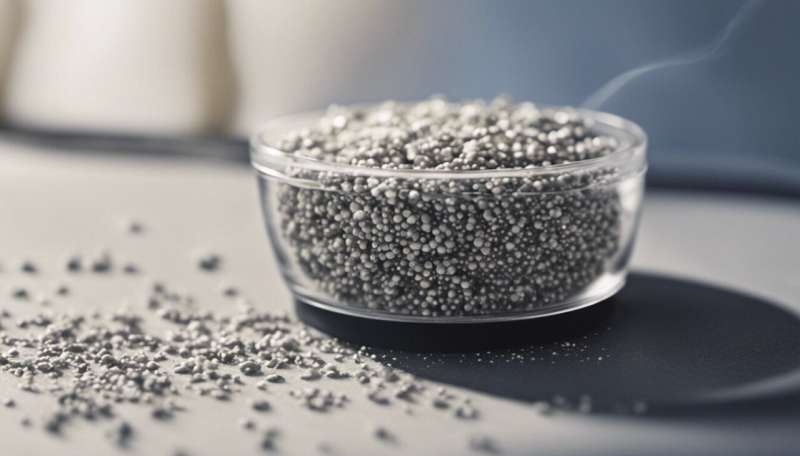This article has been reviewed according to Science X's editorial process and policies. Editors have highlighted the following attributes while ensuring the content's credibility:
fact-checked
peer-reviewed publication
trusted source
written by researcher(s)
proofread
The pollutants in our diet that could accelerate aging

Pollutants are, by definition, harmful. But not all of them are equally harmful. Of the multitude of synthetic chemical compounds that pollute our environment, those that set off the loudest alarm bells are persistent organic pollutants (POPs).
These are toxic compounds present in the environment, in water and in food. As their name suggests, their resistance to degradation makes them remain in the environment for a long time. To make matters worse, we are talking about easily diffusible compounds that accumulate in the adipose tissue of living beings and which are capable of damaging our health and the wider ecosystem. In short, they tick all the boxes in terms of causing us major problems.
To the list of problems we must add that, due to their free circulation around the globe through the atmosphere, POPs do not remain stagnant where they have been dumped. Quite the contrary: they are present all over the planet.
PCBs have a molecular structure based on carbon and chlorine. This carbon-chlorine bond is difficult to break. Therefore, PCBs have a high permanence in the environment and are resistant to degradation.
Furthermore, they are semi-volatile despite their low vapor pressure because they have the ability to repel water from their surface. That is, PCBs with less chlorine in their structure are more volatile and more persistent, and can be transported over long distances. Moreover, by repelling water, they can bind to the lipids of living organisms and accumulate in their tissues.
The also have a great capacity for biomagnification—meaning they can accumulate to reach high levels of concentration the higher up the food chain they travel. That is why it is not uncommon for POPs to end up on our plates.
Dioxins and PCBs
There are many different types of POP. At the University of Navarre, we have focused on studying polychlorinated biphenyls (PCBs) and dioxins (both omnipresent in the food chain) and particularly their presence in meat and dairy products, as well as fish and shellfish. Since certain PCBs and dioxins have similar mechanisms, it's common that they are studied together in the context of public health.
PCBs are toxic chlorinated aromatic compounds whose formula was first described by Schmidt and Schultz in 1881. They are hydrophobic compounds, which gives them the ability to react with the lipids of living organisms and, therefore, to accumulate in their tissues.
PCBs were used as industrial fluids, including dielectric coolants in capacitors and transformers, until they were banned in most countries in the 1980s.
On another note, the name "dioxins" normally groups together compounds belonging to two very different chemical structures: polychlorinated dibenzo-p-dioxins (PCDDs) and polychlorinated dibenzofurans (PCDFs).
Cardiovascular disease and cellular aging
More than 90% of human exposure to dioxins occurs through food, particularly meat and dairy products, as well as fish and shellfish. It is common to find PCBs in milk and its derivatives, but also in animal organs such as the brain and liver.
Dietary exposure to persistent organic pollutants has been associated with cardiovascular risk factors in humans. Within the group of people analyzed in the University of Navarre SUN Project ("Seguimiento Universidad de Navarra"—"University of Navarre Monitoring"), several studies showed that PCB levels obtained from dietary intake were associated with a higher risk of developing hypertension and obesity.
Likewise, other studies showed an association between dietary exposure to PCBs and coronary atherosclerosis, heart failure, obesity, type 2 diabetes, and mortality from cardiovascular diseases, among others.
Recently, researchers from the University of Navarre and the Physiopathology of Obesity and Nutrition Networking Biomedical Research Centre (CIBEROBN) have verified that high exposure to persistent organic pollutants (PCBs) through diet could also accelerate cellular aging.
The research, based on 886 volunteers over the age of 55, was published in the journal Nutrients and has shown that these pollutants lead to telomere shortening. These non-coding DNA regions are found at the ends of the chromosomes and their length, in addition to reflecting life expectancy, indicates overall state of health. They also indicate the risk of chronic diseases.
Although more longitudinal studies are currently needed to corroborate this finding, the research highlights the influence of lifestyle and, specifically, diet on the integrity of genetic material or DNA.
This article is republished from The Conversation under a Creative Commons license. Read the original article.![]()





















